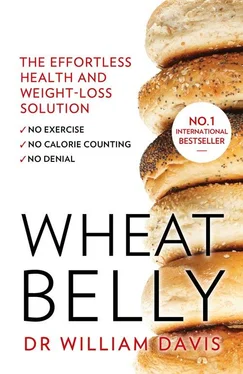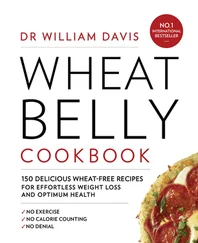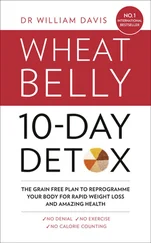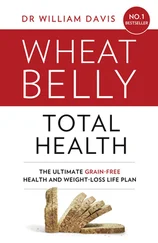
CHAPTER 1 Chapter 1 What Belly? Chapter 2 Not Your Gran’s Muffins: The Creation of Modern Wheat Chapter 3 Wheat Deconstructed PART TWO WHEAT AND ITS HEAD-TO-TOE DESTRUCTION OF HEALTH Chapter 4 Hey, Man, Wanna Buy Some Exorphins? The Addictive Properties of Wheat Chapter 5 Your Wheat Belly Is Showing: The Wheat/Obesity Connection Chapter 6 Hello, Intestine. It’s Me, Wheat. Wheat and Coeliac Disease Chapter 7 Diabetes Nation: Wheat and Insulin Resistance Chapter 8 Dropping Acid: Wheat as the Great pH Disrupter Chapter 9 Cataracts, Wrinkles and Dowager’s Humps: Wheat and the Ageing Process Chapter 10 My Particles Are Bigger Than Yours: Wheat and Heart Disease Chapter 11 It’s All in Your Head: Wheat and the Brain Chapter 12 Bagel Face: Wheat’s Destructive Effect on the Skin PART THREE SAY GOODBYE TO WHEAT Chapter 13 Goodbye, Wheat: Create a Healthy, Delicious, Wheat-Free Life Epilogue Appendix A Looking for Wheat in All the Wrong Places Appendix B Healthy Wheat Belly-Shrinking Recipes List of Searchable Terms Acknowledgements References About the Publisher
WHATBELLY? Chapter 1 What Belly? Chapter 2 Not Your Gran’s Muffins: The Creation of Modern Wheat Chapter 3 Wheat Deconstructed PART TWO WHEAT AND ITS HEAD-TO-TOE DESTRUCTION OF HEALTH Chapter 4 Hey, Man, Wanna Buy Some Exorphins? The Addictive Properties of Wheat Chapter 5 Your Wheat Belly Is Showing: The Wheat/Obesity Connection Chapter 6 Hello, Intestine. It’s Me, Wheat. Wheat and Coeliac Disease Chapter 7 Diabetes Nation: Wheat and Insulin Resistance Chapter 8 Dropping Acid: Wheat as the Great pH Disrupter Chapter 9 Cataracts, Wrinkles and Dowager’s Humps: Wheat and the Ageing Process Chapter 10 My Particles Are Bigger Than Yours: Wheat and Heart Disease Chapter 11 It’s All in Your Head: Wheat and the Brain Chapter 12 Bagel Face: Wheat’s Destructive Effect on the Skin PART THREE SAY GOODBYE TO WHEAT Chapter 13 Goodbye, Wheat: Create a Healthy, Delicious, Wheat-Free Life Epilogue Appendix A Looking for Wheat in All the Wrong Places Appendix B Healthy Wheat Belly-Shrinking Recipes List of Searchable Terms Acknowledgements References About the Publisher
The scientific physician welcomes the establishment of a standard loaf of bread made according to the best scientific evidence. . . . Such a product can be included in diets both for the sick and for the well with a clear understanding of the effect that it may have on digestion and growth.
Morris Fishbein, MD,
editor, Journal of the American Medical Association, 1932
IN CENTURIES PAST, a prominent belly was the domain of the privileged, a mark of wealth and success, a symbol of not having to clean your own stables or plough your own field. In this century, you don’t have to plough your own field. Today, obesity has been democratised: everybody can have a big belly. Your dad called his rudimentary mid-twentieth-century equivalent a beer belly. But what are mums, kids and half of your friends and neighbours who don’t drink beer doing with a beer belly?
I call it wheat belly, though I could have just as easily called this condition pretzel brain or bagel bowel or biscuit face since there’s not an organ system unaffected by wheat. But wheat’s impact on the waistline is its most visible and defining characteristic, an outward expression of the grotesque distortions humans experience with consumption of this grain.
A wheat belly represents the accumulation of fat that results from years of consuming foods that trigger insulin, the hormone of fat storage. While some people store fat in their buttocks and thighs, most people collect ungainly fat around the middle. This ‘central’ or ‘visceral’ fat is unique. Unlike fat in other body areas, it provokes inflammatory phenomena, distorts insulin responses and issues abnormal metabolic signals to the rest of the body. In the unwitting wheat-bellied male, visceral fat also produces oestrogen, creating ‘man breasts’.
The consequences of wheat consumption, however, are not just manifested on the body’s surface; wheat can also reach deep down into virtually every organ of the body, from the intestines, liver, heart and thyroid gland all the way up to the brain. In fact, there’s hardly an organ that is not affected by wheat in some potentially damaging way.
PANTING AND SWEATING IN THE HEARTLAND
I practise preventive cardiology in Milwaukee. Like many other midwestern cities, Milwaukee is a good place to live and raise a family. City services work pretty well, the libraries are first-rate, my kids go to high-quality state schools and the population is just large enough to enjoy big-city culture, such as an excellent symphony and art museum. The people living here are a fairly friendly bunch. But . . . they’re fat .
I don’t mean a little bit fat. I mean really, really fat. I mean panting-and-sweating-after-one-flight-of-stairs fat. I mean 17-stone 18-year-old women, 4x4s tipped sharply to the driver’s side, double-wide wheelchairs, hospital equipment unable to accommodate patients who tip the scales at 25 stone or more. (Not only can’t they fit into the CT scanner or other imaging device, you wouldn’t be able to see anything even if they could. It’s like trying to determine whether the image in the murky ocean water is a flounder or a shark.)
Once upon a time, an individual weighing 17 stone or more was a rarity; today it’s a common sight among the men and women walking the streets, as humdrum as selling jeans at Gap. Retired people are overweight or obese, as are middle-aged adults, young adults, teenagers, even children. White-collar workers are fat, blue-collar workers are fat. The sedentary are fat and so are athletes. White people are fat, black people are fat, Hispanics are fat, Asians are fat. Carnivores are fat, vegetarians are fat. Americans are plagued by obesity on a scale never before seen in the human experience. No demographic has escaped the weight gain crisis.
Ask the USDA or the Surgeon General’s office and they will tell you that Americans are fat because they drink too many fizzy drinks, eat too many crisps, drink too much beer, and don’t exercise enough. And those things may indeed be true. But that’s hardly the whole story.
Many overweight people, in fact, are quite health conscious. Ask anyone tipping the scales over 17 stone: What do you think happened to allow such incredible weight gain? You may be surprised at how many do not say ‘I drink Big Gulps, eat Pop Tarts and watch TV all day.’ Most will say something like ‘I don’t get it. I exercise five days a week. I’ve cut my fat and increased my healthy whole grains. Yet I can’t seem to stop gaining weight!’
HOW DID WE GET HERE?
The national trend to reduce fat and cholesterol intake and increase carbohydrate calories has created a peculiar situation in which products made from wheat have not just increased their presence in our diets; they have come to dominate our diets. For most Americans, every single meal and snack contains foods made with wheat flour. It might be the main course, it might be the side dish, it might be the dessert – and it’s probably all of them.
Wheat has become the national icon of health: ‘Eat more healthy whole grains’, we’re told, and the food industry happily jumped on board, creating ‘heart healthy’ versions of all our favourite wheat products chock-full of whole grains.
The sad truth is that the proliferation of wheat products in the American diet parallels the expansion of our waists. Advice to cut fat and cholesterol intake and replace the calories with whole grains that was issued by the National Heart, Lung, and Blood Institute through its National Cholesterol Education Program in 1985 coincides precisely with the start of a sharp upwards climb in body weight for men and women. Ironically, 1985 also marks the year when the Centers for Disease Control and Prevention (CDC) began tracking body-weight statistics, tidily documenting the explosion in obesity and diabetes that began that very year.
Читать дальше













